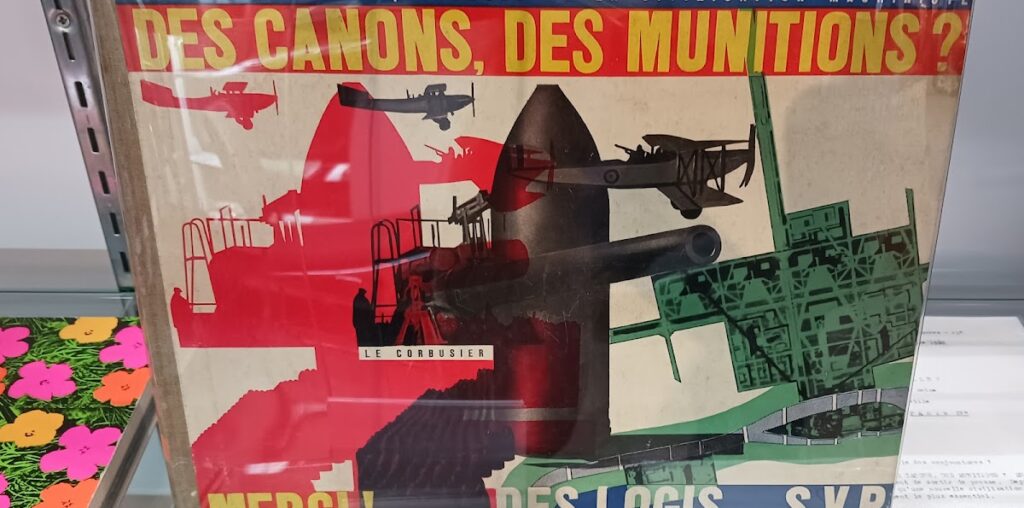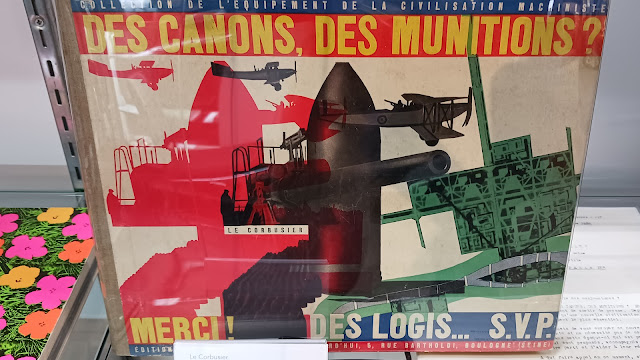Lesson 1: Corbu is (still) king.
 |
| Johnson Rare Books & Archives has a first edition of Des Canons, Des Munitions? Merci! Des Logis… S.V.P. from 1937, complete with a typed signed letter by Corbu. It is going for $7,500. |
 |
| Ursus Books is selling an “incredibly rare first edition of Le Corbusier’s legendary Farbenklaviatur [Color Keyboards …] the first of the two collections of colors which he designed for the Salubra wallpaper company” in 1931. Birkhäuser did a reproduction about 25 years ago that can be found for a few hundred dollars, but a first edition at Ursus will put you back $22,500. |
Lesson 2: Old + European = Rare + Valuable.
While walking the aisles of the fair, it felt at times that “architecture” was limited to old treatises, pattern books, etchings, and the like, all coming from Europe centuries ago. Large folios opened to drawings were in many glass cases, standing out as skilled and (once) influential creations but also anachronistic images of what many people think buildings should be: classical. Traditionally, architecture libraries — be they institutional, professional, or private — have been practical: providing guidance and inspiration for architects. Outside of a few architectural historians, that’s not the case with books like these, which are prized for their age, scarcity, and beauty, not their practicality to architects. And even if architects still used them, such as those at the Institute of Classical Architecture & Art, they’d probably use reprints rather than valuable 500-year-old originals.
 |
| Ursus Books makes another appearance here, this time with a portfolio (ca. 1810) of 24 plates by Antoine Joseph Gaitte of Claude Nicholas Ledoux’s 18th-century toll-gates in Paris. Price: $8,500. |
 |
| Books — or, more accurately, scrolls — of Vitruvius’s foundational text on architecture, De architectura, don’t exist, so later Renaissance versions of it are prized, such as this one edited by Fra Giovanni Tacuino in 1511. Erasmushaus is selling it for $65,000. (The Basel-based bookseller also has a first edition of Palladio’s Quattro Libri for $66,000.) |
 |
| The enduring legacy of Giovanni Battista Piranesi is evident in “The Grand Tour” booth of Mayfair Rare Books & Manuscripts, which has a folio with 20 etched plates of Paestum (ca. 1778) going for €25,000. |
Lesson 3: Architects love certain artists and designers.
Audience is always important when it comes to book sales. If we lump architects together as one audience, I’d argue that they purchase books outside of architecture as often as they amass books on architecture. Books on art and design are high among the former, with very particular artists and designers — ones with shared affinities for form, space, texture, etc. — standing out over others. A couple are below, plus one surprise (to me).
 |
| Architects love artists who trained as architects, and right up top is Gordon Matta-Clark, who sliced and cut open buildings, documenting the transient (de)constructions in photographs. A book of his I’d heard about but hadn’t seen in person is Walls Paper, which the artist made from photographs of partially demolished buildings in the Bronx in the early 1970s (he died in 1978 at just 35 years old). He colored the b/w photos and then cut the pages in the middle so juxtapositions are created as one flips through it. Two copies were on display at the fair: at Sims Reed Ltd. ($5,000) and Jeff Hirsch Books ($3,000). |
 |
| Who is this Utopian architectural designer that Vivien Greene supposedly called the “Edgar Allan Poe of Architecture”? I’d never heard of Albert Trachsel before coming across this signed copy of Les Fêtes réelles, an “architectural poem” he made in 1897. Martyan Lan is selling it for $9,500. |
Lesson 4: Learning from Las Vegas is the architect’s “one book.”






